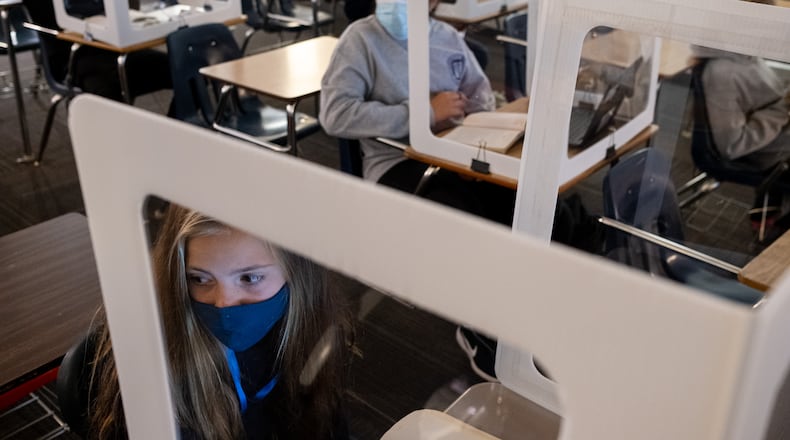Early this fall, after a widely disparaged spring semester online caused by the coronavirus pandemic, many schools across Georgia decided to return to the classroom while offering a separate online experience to the children of parents who refused.
Given the criticism in some places that online programs are separate and sometimes unequal, some school districts are trying another way that seems obvious in concept, if difficult in execution: teaching kids in school and at home together, at the same time.
It is a method that is so new and unstudied that it has no universally accepted name. “Synchronous,” “simultaneous,” “double,” and even “hybrid,” some call it.
“No one had ever done this so we had no model,” said Angie Pacholke, the principal at Freeman’s Mill Elementary School in Gwinnett County. “We were just calling it ‘live.’” The central office is calling it “concurrent” teaching.
Teachers' laptops are linked wirelessly to overhead projectors that display on whiteboards what students at home can see through shared Zoom screens. And laptops at home display what teachers write on whiteboards using old, salvaged technology that digitizes it.
While parents and teachers at Freeman’s Mill say it is working for them, it has proved too formidable for some.
For instance, Marietta City Schools tried it briefly with elementary school students but rejected it as too difficult for those teachers.
“Their heads had to be on a swivel," Superintendent Grant Rivera said. He said younger students are less disciplined and need more attention than in middle and high school, where the district is still implementing the “synchronous hybrid environment,” as he called it. That lack of a concurrent option may be a reason why only about a quarter of elementary school students there chose to remain online after their schools opened, while a larger proportion of middle school and high school students are staying home.
There were only a dozen students in an eighth-grade math class on the day after they returned to Marietta Middle School in late October, each of their desks surrounded by a plastic screen on three sides. Another 11 were at home and watching the class on Zoom. There were even fewer in Natalie Darbey’s seventh grade English Language Arts class. She was grateful that circumstances allowed the building to open.
“Prior to them coming in, it’s just been a big empty room with me interacting with a computer screen," she said. "I needed this. A lot of the students needed this.”
Credit: Ben Gray
Credit: Ben Gray
One of her students, Monserrath Guerrero, 12, said she decided to return because she found it difficult to follow along online. Celeste Martin, also 12, said she was too distracted at home by her cellphone and by her five siblings.
At Freeman’s Mill, the elementary school in Gwinnett, half the fifth graders are online, but enrollment skews more in-person in the younger grades, which have been slower to adopt concurrent learning.
That word, concurrent, is not the only newly coined one at the school:
“So Zoomies, if you will, go back to the main page and then sit tight while our roomies catch up,” Jordan Greene instructed her fifth-graders one recent morning. She held a tablet display to her camera to show her students at home how to navigate a new platform.
There was a hitch — glare on the screen — but she got around that quickly, like so many of the other technical hurdles she and her peers have encountered.
Credit: Ben Gray
Credit: Ben Gray
The 15 students in her classroom, all in masks (as in Marietta, masks are mandatory), had laptops and were on the same web page as those at home.
Greene said it was initially difficult handling both Zoom and her classroom, and there have been occasional showstoppers, like a frozen computer application. But with experience comes expertise, and the school has a technical support staff that helps. Also, experience has brought innovation, like the wireless adapters for the overhead projectors when teachers found they couldn’t move around their rooms with their laptops hardwired to them, or the idea for salvaging the old whiteboard digitizers, which came to Greene in a dream.
The face of Emely Galicia, a girl with long dark hair, briefly disappeared from the projection on the whiteboard from Greene’s laptop, as she ducked below her camera’s view, apparently trying to navigate to the new web page.
She is doing fine online, her father, Adam Galicia, said later.
The experience has been much better than the chaos of last spring, Galicia said. “It was more like a play date for the kids,” he said. "But this year is a whole different thing.”
Luther Enloe, whose daughter Lily attends kindergarten online at Freeman’s Mill, described the spring as “the Wild West" and appreciates the new, interactive routine, even if it is exhausting for him given the amount of assistance a kindergartner requires.
Enloe works from home but spends much of his day helping Lily and her older brother. Although she is part of a concurrent classroom with other kindergartners, Lily is too young to interact with them much, Enloe said, though her brother, Cole, in third grade, has made some friends through his computer screen. Both often break into small groups of students to work together on assignments.
Credit: Ben Gray
Credit: Ben Gray
Is it making a difference?
There isn’t much research about online education in K-12 schools, especially involving such a novel model. But a new paper about online college courses before and during the pandemic reached conclusions that one of the authors thinks should also apply in elementary schools.
The paper written largely by Douglas McKee and George Orlov at Cornell University found that students in classes led by educators with experience online did better on tests. So did students in classes that included small group interaction, like teamwork on an assignment.
“It seems that having students work together and having interaction made a big difference,” said McKee, senior lecturer in economics.
At Freeman’s Mill, William Leighton Caswell, 10, a fifth-grade student, took a break from a math assignment to talk with a reporter. He had been collaborating with four Zoomies. “It is kind of fun getting to know kids on Zoom,” he said.
William said this concurrent model could be useful after the pandemic, too, though some of his peers may not appreciate the implications.
“There’s almost no way you could be absent," he said, "unless you’re throwing up all day.”
Credit: Ben Gray
Credit: Ben Gray
About the Author
Keep Reading
The Latest
Featured






